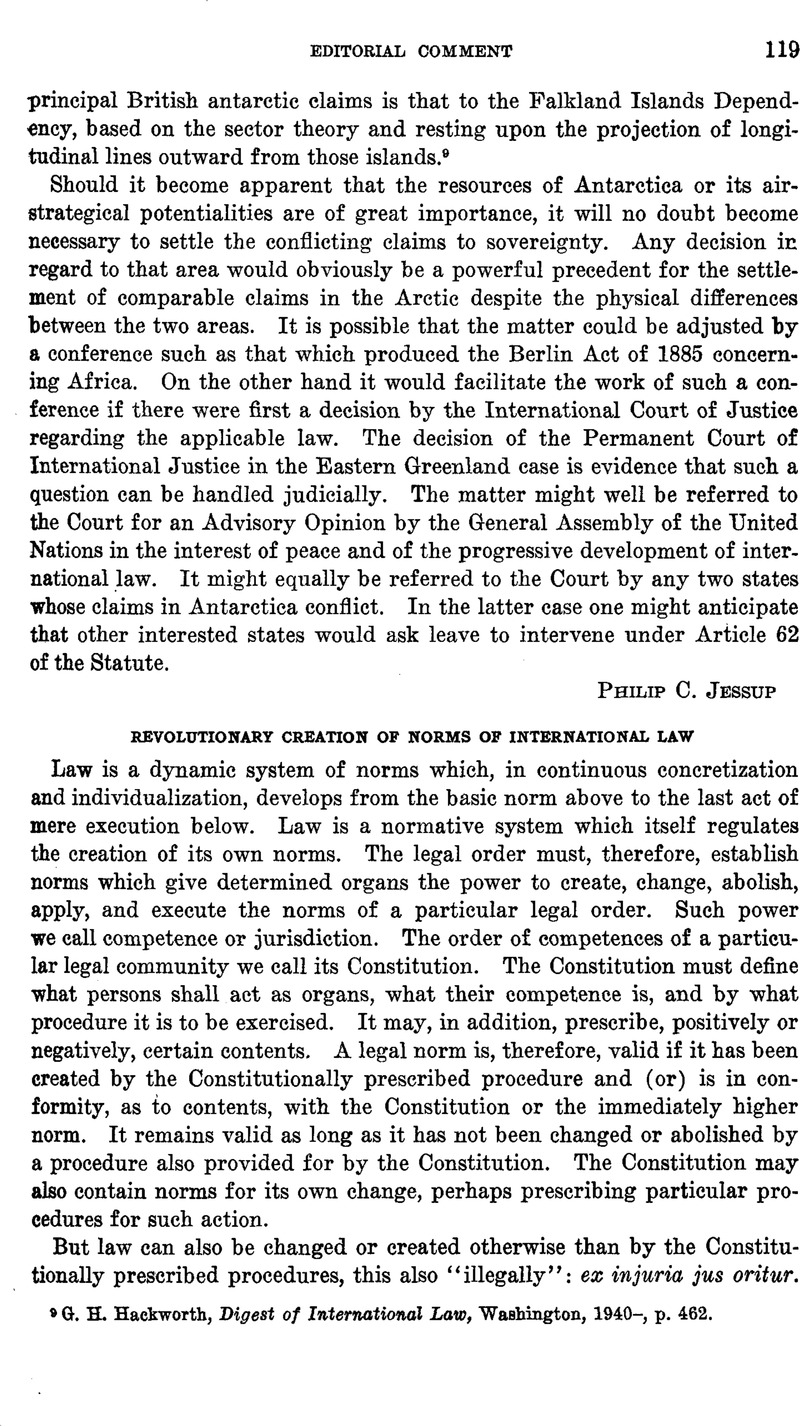Published online by Cambridge University Press: 20 April 2017

1 Kelsen, H., General Theory of Law and State, Cambridge (Mass.), 1945, p. 119 Google Scholar.
2 Erie Railroad v. TompMns (304 U. S. 64, 58 S. Ct. 817) (1938) not only overruled Swift v. Tyson, but held, repeating the words of Justice Holmes, that “Swift v. Tyson was an unconstitutional assumption of power, by courts of the United States.” Nevertheless, under the principle of res judicata Swift v. Tyson (16 Pet. 1, 10. L. Ed. 865) (1842), was valid law for ninety-six years.
3 Kelsen, work cited, p. 371.
4 Whether Italy ‘s change from monarchy to Republic was legally a revolutionary creation of law, depends on whether such change was or was not brought about in conformity with a procedure provided by the Constitution of the Kingdom of Italy in force at that time.
5 The American Republics held the change from the Vargas regime in Brazil to be Constitutional for diplomatic reasons, so as to avoid the problem of the recognition of a de facto government. But the overthrow of President Vargas by a palace revolution was, from a legal point of view, certainly revolutionary, as contrary to the Vargas Constitution of 1937, then in force.
6 Hence the paradoxical situation of the crime of treason. In positive Common Law it is the highest crime, standing in a category apart. But a successful revolution leads to an original creation of law. “Those who lose are the traitors,” says the King in Calderón’s La Vida es Sueño. An old English verse reads:
“Treason cannot prosper, What’s the reason?
For if it does, who would dare to call it treason?”
7 See Josef L. Kunz : “The meaning and the range of the norm pacta sunt servando,” in this Journal, Vol. 39 (1945), pp. 180-197.
8 At the World Health Conference, held in the Summer of 1946 in New York, it was proposed that the World Health Assembly of the new World Health Organization should have jurisdiction of enacting regulations, immediately binding upon member-States without ratification, except if specifically rejected by a member-State. The Belgian representative, rejecting this proposal, spoke of a “revolutionary change of international law.” But legally such a norm, created by the treaty procedure, with the consent and ratification of the contracting parties, and binding only upon member-States, would not be revolutionary at all.
9 E. A. Korovin, Das Völkerrecht der Übergangszeit (German translation), 1929. See also T. A. Taracouzio, The Soviet Union and International Law, New York, 1935.
10 Art. XVII.
1. In the event of a dispute between a Member of the League and a State which is not a Member of the League, or between States not Members of the League, the State or States not Members of the League shall be invited to accept the obligations of Membership in the League for the purposes of such dispute, upon such conditions as the Council may deem just. If such invitation is accepted, the provisions of Articles 12 to 16 inclusive shall be applied with such modifications as may be deemed necessary by the Council.
2. Upon such invitation being given the Council shall immediately institute an inquiry into the circumstances of the dispute and recommend such actions as may seem best and most effectual in the circumstances.
3. If a State so invited shall refuse to accept the obligations of membership in the League for the purposes of such dispute, and shall resort to war against a Member of the League, the provisions of Article XVI shall be applicable as against the State taking such action.
4. If both parties to the dispute when so invited refuse to accept the obligations of membership in the League for the purposes of such dispute, the Council may take such measures and make such recommendations as will prevent hostilities and will result in the settlement of the dispute.
See the well-known Commentaries on the Covenant by Schücking and Wehberg, Bay, and Göppert, as well as the following monographs: E. Morpurgo, “L’articolo 17 del Patto della Società delle Nazioni ed il diritto internazionale consuetudinario,” in Mevue de Droit International (Sottile), 1925, pp. 177-185); A Bavaj, L’interpretazione dell’ articolo 17 del Patto della Società della Nazioni, 1931; R. Weinberg, Völkerbund und Nichtmitgliedstaaten, 1932.
11 Goodrich, Leiand M. and Hambro, Edward, Charter of the United Nations: Commentary and Documents, Boston, 1946, pp. 70 71 Google Scholar.
12 Kelsen, H., “Sanctions in International Law under the Charter of the UN,” Iowa Law Review, Vol. 31 (1946), pp. 499 543 Google Scholar, at p. 502.
13 Work quoted, note 12, p. 512.
14 Kelsen, H., “Membership in the United Nations, ‘Columbia Law Review, Vol. XLVI (1946), pp. 391 411 CrossRefGoogle Scholar, at pp. 394, 411.
15 Permanent Court of International Justice, Publications A/22, p. 17, A/B/46, pp. 141, 143.
16 The New York Times, June 20, 1946, p. 4.
17 Permanent Court of International Justice, Publications A/23, p. 20.
18 The New York Times, July 27, 1946, p. 9. Analogously Article XXXVII of the Hungarian, XXXVIII of the Rumanian, XXXVI of the Bulgarian, and XXXIV of the Finnish Draft Peace Treaties (the same, July 31, 1946, pp. 15, 18, 19 and 21), only with the difference that the first three treaties come into force immediately upon deposit of ratification by the U. K., the U. S. and the U. S. S. R., the last upon deposit of ratification by the U. K. and the U. S. S. R.
19 Verdross, A., Völkerrecht, Berlin, 1937, p. 126.Google Scholar
20 Kelsen, work quoted, note 12, pp. 512-513.